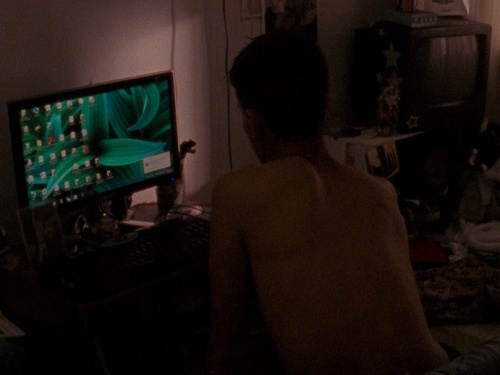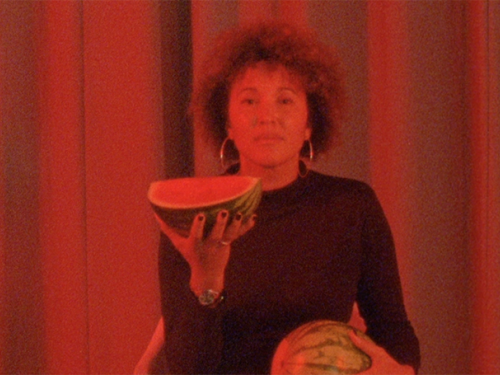Adam Roberts on Chantal Akerman: Questions About Duration
A Nos Amours at the ICA continues a retrospective of the complete film works of Chantal Akerman with two programmes dedicated to shorter work. Adam Roberts of the film collective A Nos Amours talks here about Chantal Akerman's use of short-form cinema and its effect on her artwork.
The next two instalments of the Chantal Akerman retrospective will consist of shorter works: Programme 9 includes two one hour films, while Programme 10 includes five short films. This is not a grouping for convenience, but is a reflection of what Akerman worked on in the 1980s – mainly short work made for television in France.
A question immediately presents itself: why would a celebrated filmmaker decide to work on a miniature scale after delivering a series of long-form works, including the magisterial Jeanne Dielman which runs at 201 minutes?
Why then the assumption that a filmmaker should start short and go long? In the field of poetry, long lyrical poems are not now so admired: rather the concision of the sonnet, or several stanzas of a page or two are much preferred. Who reads Childe Harold when She Walks in Beauty is so good and so short?
Tastes change, but the standardization of the feature film length appears unassailable (even if 90 minutes has now been supplanted by 110 or even 120 minutes). Rare to find a film of 80-odd minutes, enough to merit comment in any review. It is of course only in the commercial cinema that ‘feature length’ is the standard unit of measure. Film as an art practice and as a medium for gallery exhibition has never felt such constraint. Both Michael Snow and Andy Warhol (whose work Akerman came to know very early on in her life as a filmmaker) produced works of wildly varied length: Snow with Wavelength at 45 minutes and La Région central at 180 minutes, Warhol with any Screen Test at 2½ minutes and Empire at 485 minutes.
Why did Akerman go short? A few real world issues were surely impinging on her artistic ambitions.
The 1980s were far from easy times. Indeed, Akerman’s film Les Années 80 and later Golden Eighties were overt about this: times were tough. Recession and oil shocks dominated the economics of the decade. Film producers were obliged to cut their cloth. Akerman was focused on financing Golden Eighties, a project with a large cast, with ambitious production values, and likely to be in need of widespread release to recoup costs. Akerman has often doubled as producer on her projects, and this must have consumed time and energy. The film was released in 1986, and despite some compromises on the budget, was every bit as high profile and lavish as intended. The short films shot around this time, those included in Programmes 9 and 10 might well be a measure of the time available to Akerman, of the need to take advantage of small scale, readily achieved commissions.
It is also worth noting that the 80s were fertile times for short-form TV commissioning, generally shot on 16mm and shown together in curatorial strands or portfolio formats. This happened in France, as in the UK when Channel 4 came into being. For example, Un jour Pina a demandé was commissioned as part of a series called ‘Repères sur la modern dance’; Lettre de cineaste was part of series called ‘Cinema Cinema’; and Family Business was commissioned as part of the Visions strand on Channel 4.
These shorter works present distinct possibilities. They are not required to deliver a comprehensive view. They can be, and often are, formally inventive, gnomic, quizzical, incomplete, mysterious, enigmatic… They take risks with audiences that simply would not be taken working in long-form.
A good example is the short film Le marteau (The Hammer, part of Programme 10). This is a four minute film from 1986, shot for French television, ostensibly about the artist Jean-Luc Vilmouth. The hammer is the tool a sculptor uses to chip away at the block; it is, for Vilmouth, emblematic and he has made the outline of a mason’s hammer his icon. Akerman here instigates a game of musical chairs, as if the loss of a chair and the removal of participants reflects the artist chipping away at a block. The winner, the person emblematic perhaps of a sculptural form, is then permitted to take a hammer from a wall (where it has been displayed as kind of artwork in relief) and hurl it out into the starry night. The hammer whirls and twirls against the stars, the strings that hold it aloft quite visible. In other words, an intensely elliptical, oddly fascinating work.
These shorter works of Akerman’s contain marvels. L'homme à la valise is very funny, a beautifully composed study in psychological warfare that Buster Keaton would have approved of. Lettre de cineaste is a playful antidote to any expectation of highbrow seriousness from the author of Jeanne Dielman. J’ai faim, j’ai froid is a physical comedy offering zestful rhythmical play, and may just be an autobiographical fragment. Un jour Pina a demandé is a wonderful encounter between two women artists, a work that has been far too infrequently seen.
Short forms and miniatures can be symbolic in a way that long-form may not be. There is something about a microcosm that can bear the weight of ponderous significance better than a longer work, where nuance and delicacy are prized. In a short film there is no expectation that meaning will be made clear by the end of the work. Short allows digestion at leisure: short forms can be inexplicable, a time bomb of meaning set to detonate later on. Short can be a tatty affair that need not dress itself up in fine clothes. We allow short forms to be provisional, not quite sure of themselves. We allow short form to short change us. ■
Many of the films in these screenings will be accompanied by new subtitles, never having been translated before into English. We're delighted to be joined by Chantal Akerman for the screening of Programme 9.
Please note that all films are 18+ unless otherwise specified.
This article is posted in: Articles, Film
Tagged with: Adam Roberts, Chantal Akerman, Film, Andy Warhol, Michael Snow, 1980s, Short Film





